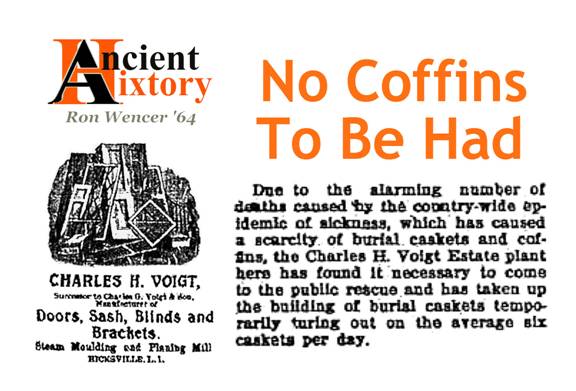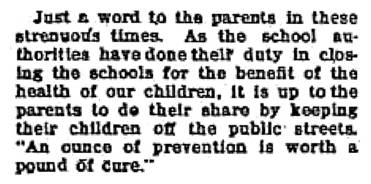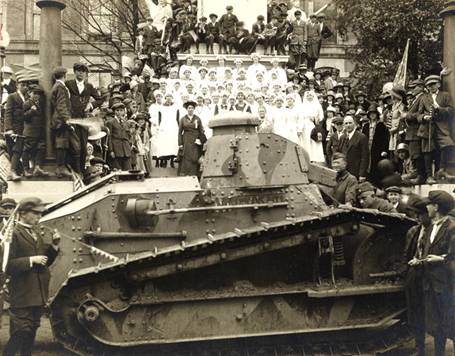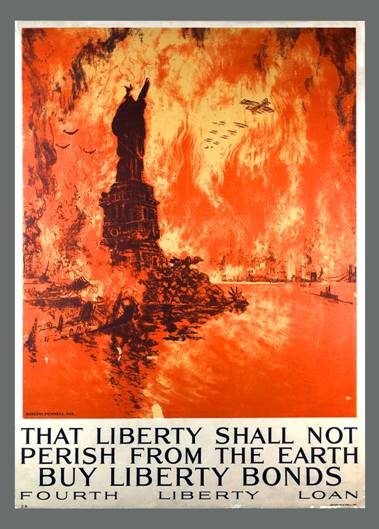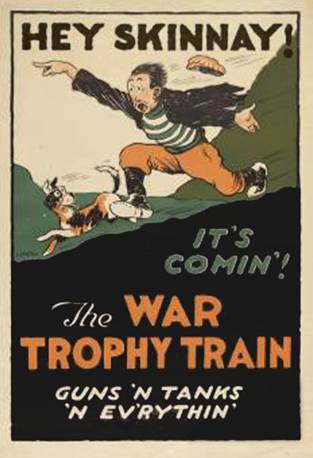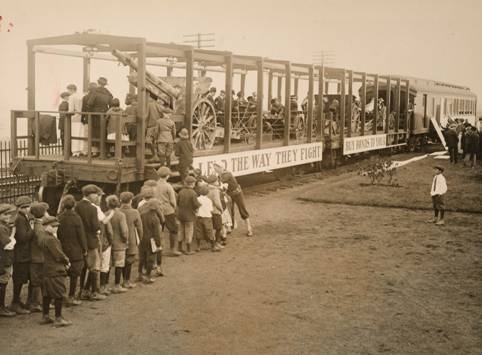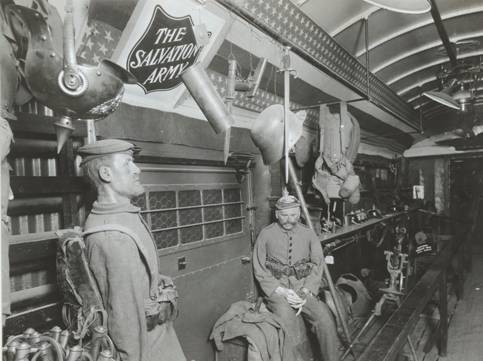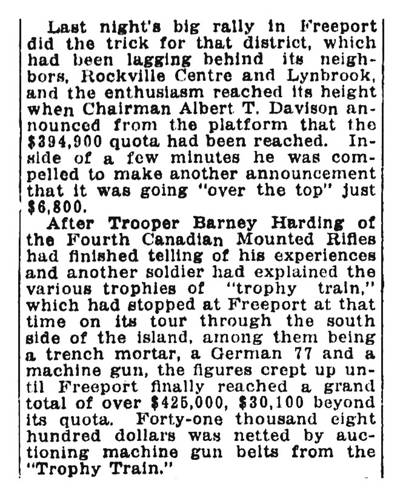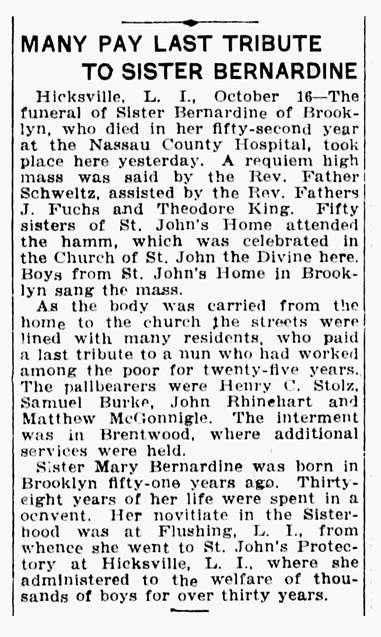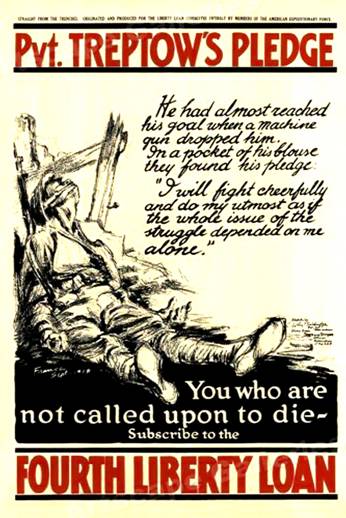By
October 1918, the number of American war casualties was growing rapidly.
At home, a
Life was supposed to feel normal, but
it wasn't - not in
No one took the trouble to coin the
phrase "social distancing," but clearly, people understood the idea
well enough where their children were concerned.
If you kept your family's children at home, isolating them from
others who might be sick, they just might survive. Adults were another matter.
Everyone had to work, especially when there was a war on.
And people needed to kick back and socialize now and then;
everybody knew that. When
parents came home, they would kiss and hug their families.
Their children would look to see if their fathers had brought
them candy or little gifts. Children's
eyes were too innocent to notice any tiny viruses.
Paradoxically, parents who kept their
children home from school would take them to the many festive
government-sponsored rallies created to support the war effort.
The rallies were like little county fairs: parades, military
bands, exhibits of machines (in this case, weapons).
Parents were excused from work.
Children shared the excitement with the friends from whom they
normally were isolated, running to line up together, sharing cups of
lemonade. In dreary wartime,
the rallies seemed like gifts from the government.
No one had been told that the
nation's top medical experts had urged the Wilson administration not
to stage parades or rallies like these, for fear that such events would
magnify the spread of the lethal epidemic.
Indeed, during the entire epidemic, the President would make no
public mention of it.
The government wanted life to be as
normal as possible. It even
went so far as to urge the mourning mothers of dead servicemen to wear
white, not black, so that they would not stand out so much in public.
Woodrow Wilson had visited "The
force of an idea lies in its inspirational value. It matters very little
if it is true or false." The administration did its best to
censor news reports that might reveal the epidemic's breadth and
depth, for fear that public resolve to win the war might be weakened.
Although theoretically in the dark, the people were not as
stupid, or as blind, as the government seemed to think.
Schools were closed nearly everywhere.
Newspapers carried more obituaries than before, sometimes more pages
of obituaries. Many funeral
directors had to store filled coffins outside their establishments.
In Queens, St. John Cemetery was using a steam shovel to dig
temporary mass graves for them; another cemetery was storing them in its
utility sheds. Normal?
Life in 1917 had been normal.
Life in 1918 was terrifying.
Once
again, it mattered very little if it was true or false.
The government was not above using the terror of the times to
raise money for the war, as seen in the poster above.
The image was pure propaganda, not prophecy.
It was an impossible nightmare, concocted to scare people into
again buying Liberty Bonds. A
poster like this was the stick; the candy was a traveling display of
"war trophies."
Soldiers from Hicksville (and in
general, from anywhere in the country) had first arrived in France early
in September of 1917. By
that time, after three years of European combat, prisoners has been
captured and exchanged, the front had moved back and forth multiple
times, and many men had died on "the wrong side" of it.
Much equipment and weaponry had been captured or simply abandoned
in place. Discards were
everywhere: helmets, uniforms, defunct artillery pieces, indeterminate
objects bearing insignia. It
all became fodder to use for fund-raising.
Much to Hicksville's dismay, the
"Pershing Train" was behind schedule when it rolled into town, and
thus its stop was briefer than planned.
All town businesses had been closed for the afternoon.
While waiting for the delayed train, a band from one of the local
military airfields played for the crowd, and it also accompanied the
singing of two soloists who were stationed at the field.
The last two Civil War veterans residing in Hicksville presented
the village with a large new flag, which was hoisted on the pole at
Depot Square. More than
$40,000 worth of bonds was sold.
The
"Trophy Train" concept has survived; Russia recently has been using
it in an attempt to boost citizen support for its military presence in
Syria. See the Appendix
below.
It is impossible for us to
fathom how life in Hicksville already had changed since the war began.
Now influenza was to warp it even more.
Until this autumn, schools
had not been drastically affected by the war.
Some male teachers and alumni had left for military service, as
had the brothers or fathers of many current pupils.
The schools mounted patriotic displays as expressions of
solidarity. Little by little, and then
suddenly, a lot by a lot, life changed further.
Influenza returned, first reported without alarm as having
surfaced in military posts and arriving ships.
The reports quickly grew worse.
People now recalled the horrifying news stories they had read
when it hit Spain in the spring, and everyone had begun calling it the
"Spanish Influenza." The
streetscape was changing. Spitting
was banned; cuspidors were removed.
Healthy people wore masks designed to impede bacteria - they
did not realize that viruses were much smaller, so small that the masks
would not stop them. Nor
were they told that many of the nurses and doctors who relied on those
same masks were themselves dying of the flu.
There was one place in
Hicksville where it did not matter at all if classes were suspended: St.
John's Protectory. The
orphanage / working farm / school had opened in the 1890s as a refuge
for homeless children. It
was a rural extension of Brooklyn's higher-capacity St. John's Home,
which had been established in 1868.
Both homes were operated by the Sisters of St. Joseph.
The boys in the Protectory slept in a
dormitory, ate together, had classes together - and none of them had
family homes to which they could be evacuated.
Influenza had reached the institution in early autumn.
By New Years, fully half of its boys, and a number of its adults,
including the Superintendent, would be suffering from it.
The Daily
Long Island Farmer noted that Sister Bernadine had died of
influenza. On the same day,
it also reported the death of Hicksville's Cpl. Walter S. Wheeler, who
had been hospitalized almost immediately upon his regiment's arrival
in France. He must have
contracted influenza on one of the densely-packed "floating coffin"
troop ships, which health officials had urged the government to stop
using. After some time in a
French hospital, Wheeler died of the pneumonia with which the influenza
had left him. Not all of the
village's victims would die in Hicksville.
To put things into perspective for contemporary readers.... The same issue of the Farmer reported the current epidemic statistics for New York City. The previous day's total for new influenza cases was 4,925. The day's total death count from influenza and pneumonia was 658. The cumulative figures were 42,911 reported cases, and 4,469 deaths. Health officials warned that these numbers understated the reality. The epidemic would get worse, it then
would seem to recede, and a third wave would hit again.
It would be a long time until things were normal again - for
those who survived.
Given President Wilson's failure to
publicly respond to the first pandemic in modern times, and his failure
to follow through on expert advice he was given, it seems prudent to
make some observations about him. Warning:
Since first learning about him years ago in Hicksville, I have lowered
my estimation of Wilson, as soon will be apparent. He had been a respected academic and
administrator, but he was not the typical scholar who published articles
on, say, medieval literature or philosophy.
He was a student of political science and public policy.
He thought himself a visionary who could improve, even reshape,
society through government. Thus,
he left academia (he was President at Princeton) to become Governor of
New Jersey; he next was elected the nation's President.
As his status advanced, his aspirations grew accordingly; World
War I further magnified his global prestige.
Wilson devoted most of his presidency not to domestic matters,
but instead to devising plans for the restructuring of a post-war
Europe, perhaps even the world, according to his own ideals.
People thought the President a
monomaniac, concerned only with the conduct of the war.
They were almost correct.
He did want a quick victory
- but not necessarily to save lives, or to "bring the boys home."
Rather, he was in a hurry to begin restructuring Europe and its
colonies.
Those who served the United States in
uniform during World War I believed that their country had gone to war
for a reason. They believed
that they were serving to help win the war, and that in the struggle,
they might be put in mortal peril. They
knew that they might be "called upon to die" for the nation's
sake. When the epidemic was reaching its height, statistics quickly confirmed the predictions about crowds with which scientists had warned officials at many levels of government. Yet, unknowing thousands of soldiers still were crammed into troop trains, squeezed too many to a seat as trains traveled to the East Coast. By the time some trains reached their destinations, corpses of young soldiers were stacked in the baggage cars. Similarly, overcrowded troop ships still sailed the Atlantic for a week or more. By the second day out, the first of the dead were being buried at sea. When the ships arrived in England or France, the freshest corpses were unloaded, and the sickest men were brought to hospital wards. The rest of the men, many of them infected and contagious, began their march eastward. Had these men - had the civilians
who were dying only because they had attended rallies or parades -
learned that many Mayors and Governors, and certainly their President,
had been urged to save their lives just by doing things differently,
what would they have thought? That
they were being "called upon to die" for the sake of their country?
Scores of wartime reports from Long
Island and New York City newspapers served as the basic sources of
information for this article. These
newspapers are named in the captions and throughout the text above. In addition, there is an abundance of
relevant online resources available; I attempted to limit myself to
those which seemed the most reputable.
Again, the most relevant of those which I used are shown in the
captions. Not for the first time, the revised
edition of John Barry's book The
Great Influenza provided vivid and stirring accounts of America
during the pandemic. Margaret MacMillian's award-winning Paris
1919, Six Months That Changed the World also was an invaluable
source.
If you can stomach more of my writing,
the following past Ancient Hixtory
articles touch on the World War I / pandemic years: June 2018: Hicksville flies Service
Flags for those who serve, and three Hicksville soldiers die of disease
in Europe January
2019: Leading citizens of Hicksville are charged with rioting when a
local mob threatens State Troopers (article illustrates anti-German war
propaganda and mania) May 2019: More in-depth accounts of
the war, the pandemic, and the three Hicksville soldiers who died in
service of their country
|
